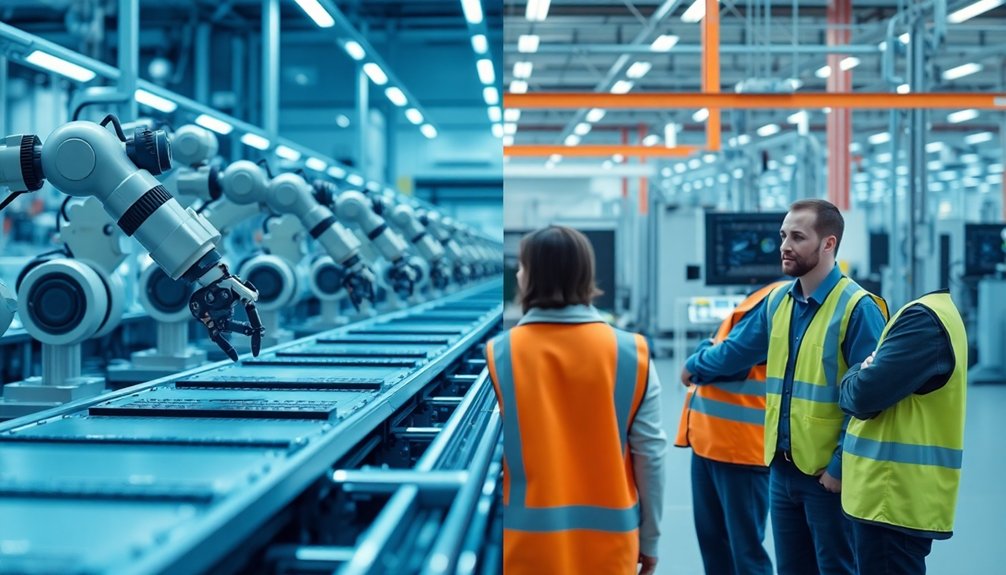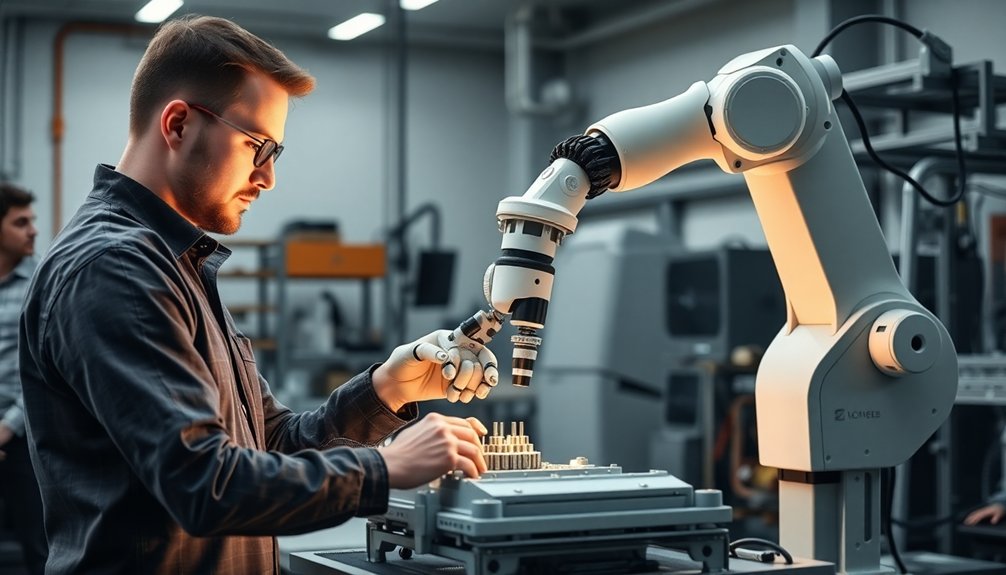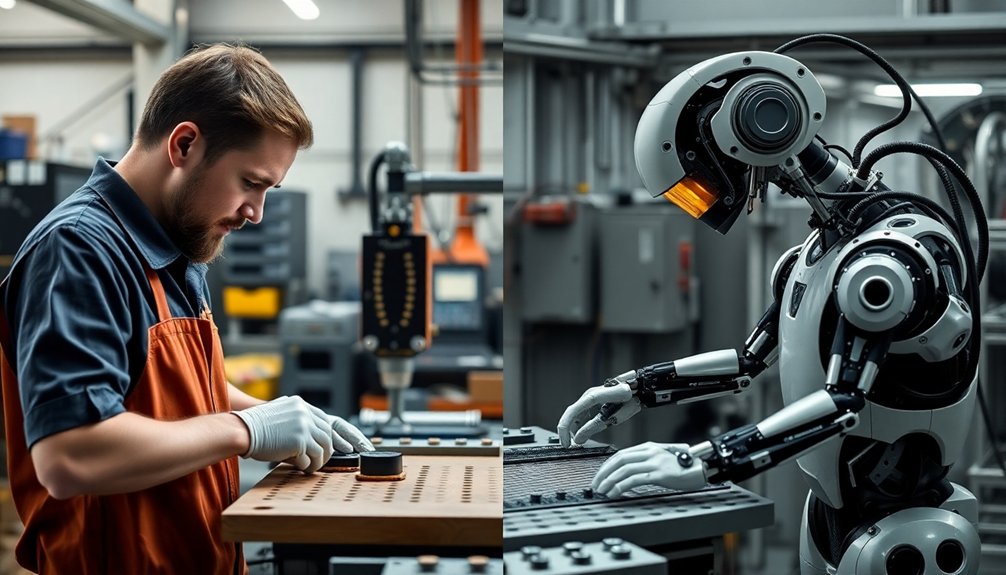Robots won’t just swoop in and steal your job—they’ll transform how you work. AI-powered machines excel at repetitive tasks but can’t replace human creativity and emotional intelligence. Think of them as high-tech teammates, not job-killing overlords. They’ll handle the mundane stuff while you tackle complex problems that require nuanced thinking. Your adaptability is your secret weapon. Want to know how to turn robots from competitors into collaborators?
The Economic Impact of Robotic Automation

While robots might seem like sci-fi fantasies, they’re already reshaping our economic landscape in ways that’ll make your head spin.
AI-powered robots aren’t just cool tech—they’re job-eating machines transforming how we work. One robot per 1,000 workers can zap 400,000 jobs and drop wages by 0.42%.
Think you’re safe? Think again. Automation hits hardest in routine manual jobs, crushing lower and middle-class workers across industries.
The automotive sector’s already feeling the heat, with robots replacing humans faster than you can say “assembly line.” And it’s not slowing down.
By 2025, robot numbers could quadruple, potentially shrinking employment and wage growth.
The future isn’t about humans versus robots—it’s about how we’ll adapt when machines start doing our jobs better, cheaper, and without coffee breaks. Workforce automation trends suggest that neural network algorithms are enabling sophisticated approaches to replace human labor across multiple industries.
Job Displacement Across Industries
As robots infiltrate workplaces like digital mercenaries, no industry is truly safe from their mechanical takeover. Manufacturing jobs are bleeding out first, with blue-collar workers taking the hardest hit. You’ll want to see how widespread job displacement is becoming:
| Industry | Robot Impact | Job Risk |
|---|---|---|
| Automotive | High | 38% |
| Manufacturing | Critical | 60% |
| Construction | Emerging | 25% |
Automation isn’t just coming—it’s already reshaping human labor. AI tools are quietly rewriting workplace dynamics, slicing through routine manual jobs like a hot knife through butter. Each robot added to your workplace potentially eliminates six workers, creating a silent economic battlefield where technology slowly conquers traditional employment. The most vulnerable? Lower and middle-class workers without college degrees. Your skills might be next on the chopping block, so stay adaptable or risk becoming obsolete in this brave new robotic world. Neuromorphic computing is accelerating the trend of robotic workforce integration, potentially amplifying the pace of job displacement across multiple sectors.
Human-Machine Collaboration Potential

You’re standing at the crossroads of a workplace revolution where robots aren’t here to steal your job, but to make you look like a superhero at it.
Imagine cobots as your hyper-efficient sidekicks, handling repetitive tasks while you focus on the creative, strategic thinking that machines can’t touch.
Advanced AI companions are learning to respect human emotional boundaries, ensuring collaborative interactions that maximize both machine efficiency and human potential.
Synergy Through Collaboration
Since the dawn of industrial automation, humans have nervously watched machines creep closer to their workspaces—but collaborative robots are flipping that script entirely.
You’re not being replaced; you’re getting a high-tech teammate. Cobots aren’t here to steal your job—they’re designed to make you look brilliant. AI-powered robots handle the mind-numbing, repetitive tasks while you tackle complex challenges that require genuine human creativity and emotional intelligence.
Imagine a workforce where humans and machines dance in perfect synchronization. Your robotic partner detects obstacles, prevents accidents, and boosts productivity without breaking a sweat. Humanoid robots in healthcare are already demonstrating how advanced AI can enhance human capabilities across various professional domains.
It’s not about competition; it’s about collaboration. These smart machines amplify your skills, turning you into a superhuman problem-solver who can accomplish more than ever before.
Ready to embrace the future?
Augmenting Human Potential
The dance between humans and machines is getting more intricate, and we’re no longer talking about robots replacing workers—we’re exploring how they can supercharge your professional potential.
Collaborative robots aren’t here to steal your job; they’re your new workplace wingman. Imagine AI and robots as power-boosting sidekicks that help you tackle complex tasks more efficiently.
These technological partners are designed to create new jobs and augment human potential, not eliminate it. By 2025, over 97 million new roles will emerge from this human-machine collaboration.
Your uniquely human skills—creativity, emotional intelligence, nuanced judgment—remain irreplaceable. Robots handle repetitive work, freeing you to focus on innovation.
The future isn’t about competition; it’s about strategic partnership where technology amplifies what you already do brilliantly. In eldercare, for example, robotic companions demonstrate how technology can support human capabilities without fully replacing emotional connection.
Adaptive Work Environments
As workplace dynamics evolve, adaptive environments are transforming how humans and machines collaborate, breaking down traditional barriers between technological tools and human talent. Deep reinforcement learning enables robots to optimize movements and tasks across various work settings, creating more intelligent and responsive collaborative systems.
Imagine cobots not as replacements, but as your smart, tireless teammates. These collaborative robots are designed to handle repetitive tasks while you tackle complex challenges that require human creativity and emotional intelligence.
Think of adaptive work environments as your productivity playground. Robotic process automation and AI optimize inventory and scheduling, freeing you to make strategic decisions.
The World Economic Forum predicts this shift will create 97 million new jobs – positions that blend human intuition with machine precision. Your unique skills become more valuable, not less.
Who’s really in charge here? Spoiler alert: you are.
Technological Limitations of AI Workforce Replacement

While robots might seem like they’re ready to take over every job on the planet, the reality is far more nuanced. AI will replace some tasks, but not entire workforces. Collaborative robots work best alongside humans, not instead of them. Neuromorphic computing enhances machine learning capabilities by mimicking brain-like neural networks, yet still cannot fully replicate human cognitive complexity.
Sure, technological advancements are impressive, but replacing humans isn’t as straightforward as sci-fi movies suggest. Think about complex jobs requiring emotional intelligence, creativity, and abstract thinking—these are still human superpowers that machines can’t easily replicate.
Tech can’t match human creativity and emotional depth – our superpowers remain uniquely our own.
Robots excel at repetitive, precise tasks, but they struggle with nuanced decision-making. The need for human insight remains critical. Can a robot truly understand customer emotions or develop innovative solutions? Nope.
While AI continues evolving, human workers aren’t becoming obsolete anytime soon. We’re partners in progress, not competitors.
Skill Adaptation in the Age of Artificial Intelligence
You’re staring down a workforce revolution where your skills aren’t just tools, they’re survival mechanisms against AI’s rapid transformation. Digital twin simulations provide advanced training environments where robots learn complex tasks without physical risk, suggesting that collaboration is more likely than total replacement.
While robots might seem poised to steal your job, the real game is learning to partner with them—think of it like dancing with a partner who knows every technical step but needs your creative improvisation.
Your career’s future hinges on continuous learning: picking up AI-adjacent skills, understanding technological trends, and positioning yourself as an adaptive professional who can collaborate with, not compete against, intelligent machines.
Skill Evolution Strategies
Despite the looming specter of AI-driven automation, workers aren’t destined to become obsolete—they’re becoming adaptable shapeshifters in a technological ecosystem that demands constant reinvention.
The need to create new opportunities isn’t just about survival; it’s about strategic skill transformation. Workers adapt by embracing continuous training programs that turn technological threats into personal advantages.
Think of it like learning a new language before everyone else—you’re not just keeping up, you’re getting ahead. With 97 million AI-related jobs on the horizon, your willingness to learn becomes your most valuable career currency.
Smart professionals aren’t hiding from robots; they’re learning to dance alongside them, understanding that adaptability isn’t just a skill—it’s a superpower in the AI-powered workplace of tomorrow. Reinforcement learning strategies demonstrate how adaptive intelligence enables workers to transform potential into intelligent career growth.
Human-AI Work Synergy
From mastering new skills to dancing with technological partners, workers now face a more complex challenge: creating meaningful partnerships with AI-powered robots.
Human-AI work synergy isn’t about replacement—it’s about collaboration. Collaborative robots (cobots) aren’t stealing your job; they’re your new workplace wingman, handling repetitive tasks while you unleash your creativity.
Continuous training becomes your secret weapon, transforming potential robot competition into partnership. Your distinctly human skills—intuition, emotional intelligence, problem-solving—are irreplaceable gold.
Think of skill adaptation like learning a new dance: sometimes awkward, always evolving. Companies investing in workforce AI training are basically giving employees a technological superpower.
Humanoid robot technologies are revolutionizing workplace dynamics, demonstrating how advanced robotics can complement human capabilities across various industries.
The future isn’t human versus robot; it’s human and robot, working together to solve problems neither could tackle alone.
Ready to embrace your robotic teammate?
Continuous Learning Imperative
When artificial intelligence starts nibbling at job descriptions like a digital piranha, continuous learning transforms from a nice-to-have into a survival strategy. Your career’s lifeline now depends on staying ahead of automation’s curve.
Consider these AI-powered adaptation tactics:
- Embrace upskilling programs that teach emerging tech skills
- Develop cross-functional capabilities beyond your current role
- Actively track labor market transformations driven by AI
- Invest in personal learning platforms and micro-credentials
You can’t afford to be a passive spectator in this technological revolution. The robots aren’t just coming—they’re already reshaping workplaces faster than you can say “machine learning.”
Your adaptability is your greatest asset. Companies like Amazon are betting on worker retraining, and you should too. The future belongs to those who can dance with digital disruption, not those paralyzed by fear of obsolescence.
Future Workforce Transformation Strategies
Three critical workforce transformation strategies are emerging as AI and robots reshape the professional landscape.
First, you’ll need aggressive upskilling initiatives that go beyond basic AI training. Think of it like learning a new language—except this language is coded in productivity and survival. Companies like Amazon are already investing in transformational strategies that prepare employees to collaborate with machines, not compete against them.
Your future workforce won’t just need technical skills; they’ll require emotional intelligence and complex decision-making abilities that robots can’t replicate.
Picture yourself as a human-AI team, where your creativity and nuanced thinking complement robotic efficiency. The key? Stay adaptable, continuously learn, and view AI as a powerful partner, not a replacement.
People Also Ask About Robots
Can AI Replace Human Workers?
You’ll likely see AI replace routine tasks, but it won’t completely eliminate human workers. Instead, you’ll need to adapt, learn new skills, and collaborate with technology to remain competitive in an evolving job market.
Can a Robot Really Replace a Human?
You’ll find robots can replace routine tasks, but they can’t match your creativity, emotional intelligence, or complex decision-making skills. They’ll enhance productivity, yet they won’t fully substitute human workers in nuanced professional environments.
What Jobs Cannot Be Replaced by AI?
You’ll find AI can’t replace jobs requiring deep empathy, creativity, complex critical thinking, compassionate care, and hands-on skills. Therapists, artists, managers, healthcare professionals, and skilled tradespeople remain irreplaceable due to their uniquely human capabilities.
Do 14% of Workers Claim to Have Already Lost a Job to Robots?
Wondering if robots are stealing jobs? According to the study, you’re not imagining it – 14% of workers have indeed experienced job displacement due to automation and AI technologies in recent years.
Why This Matters in Robotics
As robots inch closer to mimicking human skills, you’ll need to see them as dance partners, not replacements. The future isn’t about machines stealing jobs, but reshaping how we work. You’ll adapt, learn new skills, and find ways to collaborate. Some roles will vanish, others will emerge. The workplace landscape is transforming, and you’re not just a spectator—you’re the choreographer of this technological tango.
